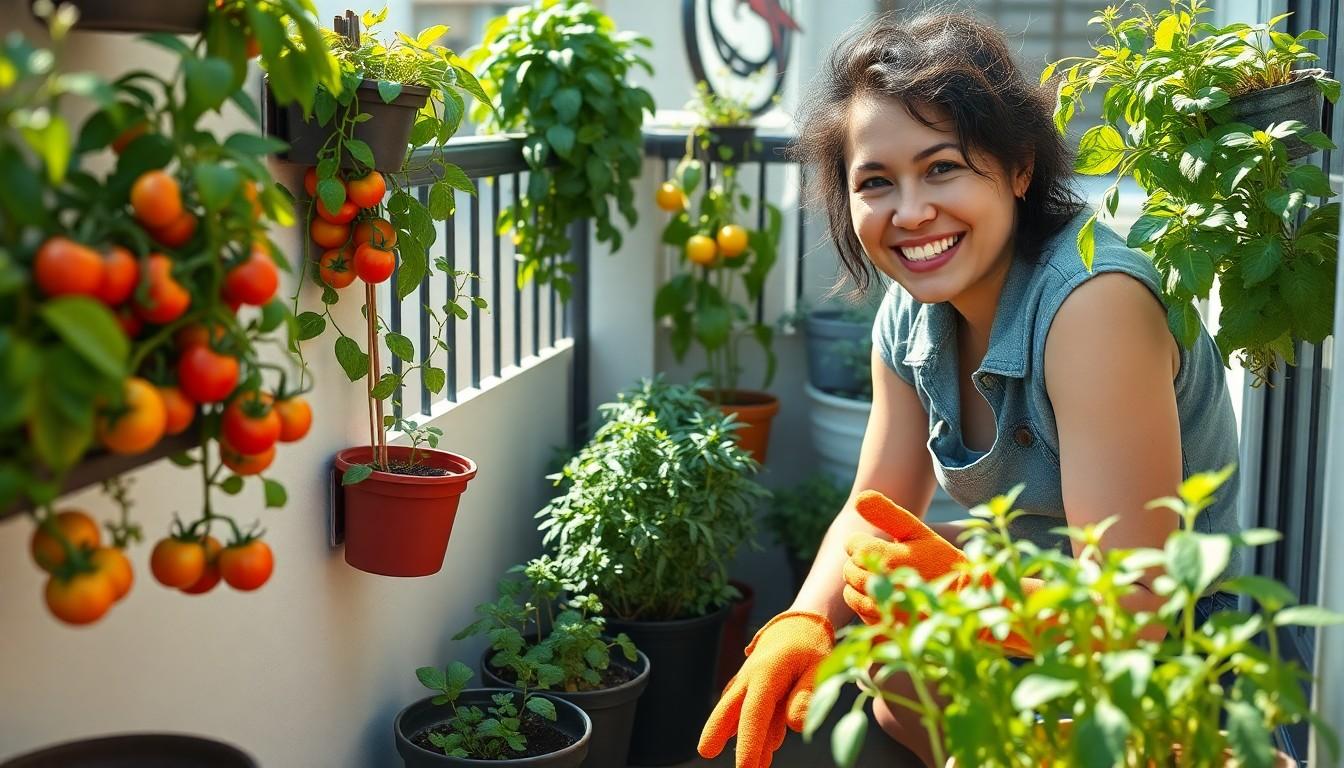In a world where square footage often feels like a luxury, small space gardening is the superhero every urban dweller needs. Who says you can’t grow your own herbs or vegetables in a tiny apartment? With a little creativity and a dash of determination, even the smallest balcony or windowsill can transform into a lush oasis.
Gardening In A Small Space
Gardening in a small space offers unique opportunities for creativity and sustainability. Urban residents often find ways to transform limited areas into productive green zones.
Benefits of Small Space Gardening
Small space gardening provides access to fresh food and herbs, enhancing meal quality. Growing plants in confined settings also promotes mental well-being through stress reduction. Space constraints encourage innovative gardening techniques. With vertical gardens, container gardening, and hydroponics, individuals maximize their growing areas. Gardening also cultivates environmental benefits, like better air quality and habitat protection, which contribute to urban biodiversity.
Common Challenges Faced
Limited space poses significant challenges for small space gardeners. Soil quality may impact plant health due to urban pollutants. Access to sunlight can be restricted by buildings and trees, affecting growth rates. Additionally, gardeners often struggle with water management in smaller areas, leading to over- or under-watering. Pest control remains essential as confined spaces can encourage infestations. Understanding these challenges helps individuals adapt their strategies for successful small space gardening.
Planning Your Small Space Garden

Effective planning lays the groundwork for a successful small space garden. Careful assessment of available space and smart plant selection play critical roles in maximizing gardening potential.
Assessing Available Space
Begin by measuring your gardening area, whether it’s a balcony, patio, or windowsill. Identify sunlight exposure throughout the day, as some plants thrive in full sun while others prefer partial shade. Consider utilizing vertical space by installing wall planters or shelves to create additional growing areas. Taking note of access points for watering and maintenance ensures easy upkeep. Additionally, check for unobstructed airflow, as good circulation supports plant health.
Choosing the Right Plants
Select plants that suit your growing environment and available light. Opt for compact varieties of vegetables, such as cherry tomatoes and dwarf peppers, which flourish in limited space. Incorporate herbs like basil and mint, known for their adaptability and growth potential in containers. Prioritize fast-growing plants to maximize harvest potential within shorter timelines. Researching companion planting enhances yield through beneficial plant relationships. Utilize native plants when possible, as they often require less maintenance and provide support for local wildlife.
Types of Small Space Gardening
Small space gardening includes various techniques that efficiently use limited areas. These methods enable urban gardeners to maximize their growing potential while enjoying the benefits of fresh produce.
Vertical Gardening Options
Vertical gardening utilizes wall-mounted planters, trellises, and hanging pots. This method allows gardeners to grow herbs, vegetables, and flowers upward, saving floor space. Using wall gardens, plants like strawberries, cherry tomatoes, and climbing beans thrive. A variety of vertical structures are available, such as pocket planters and modular systems, making them suitable for any small area. Regular watering and light management ensure these plants remain healthy and productive. When sunlight is scarce, choosing shade-tolerant varieties contributes to success in vertical gardening.
Container Gardening Ideas
Container gardening involves using pots, buckets, or other receptacles to grow plants. A wide range of containers exists, from traditional terracotta pots to modern fabric grow bags. This style accommodates diverse plants, including lettuce, peppers, and herbs like basil and mint. Proper drainage and soil selection enhance plant growth and prevent root rot. Placing containers on balconies, patios, or even windowsills maximizes available space. It’s essential to consider container size, as larger pots retain moisture better during dry spells. Regularly changing container arrangements can keep gardening spaces dynamic and enjoyable.
Tips for Successful Gardening In A Small Space
Gardening in limited areas brings unique challenges, but effective strategies can enhance success. Focusing on sunlight and watering techniques can significantly improve plant growth and yield.
Maximizing Sunlight Exposure
Evaluate light conditions early on. South-facing windows often receive the most sunlight, making them ideal for plant placement. Use reflective surfaces, like mirrors, to boost light availability. Consider lightweight sheer curtains to filter harsh sunlight while still allowing brightness through. Also, select plants based on their sunlight requirements, opting for low-light varieties if necessary. Regularly rotate pots to ensure even light distribution. Ample sunlight is crucial for photosynthesis, so making these adjustments can enhance overall garden health.
Efficient Watering Techniques
Establishing a consistent watering schedule promotes healthy plant growth. Early morning watering allows plants to absorb moisture before heat increases. Use self-watering containers to minimize effort while ensuring adequate moisture levels. Drip irrigation systems provide efficient watering, directing water to the roots without waste. Additionally, mulch can help retain moisture in the soil. Monitor plants closely for signs of overwatering or drought stress. Adopting these watering strategies can support vibrant plants in compact spaces, maximizing the gardening experience.
innovative gardening techniques
Small space gardening offers a world of possibilities for urban dwellers eager to cultivate their own green oasis. By embracing innovative techniques and planning effectively, anyone can transform limited areas into productive gardens. The benefits extend beyond just fresh produce; they enhance overall well-being and contribute positively to the environment.
With the right approach and a bit of creativity, small spaces can flourish with vibrant plants. Whether it’s utilizing vertical gardens or container gardening, every inch can be optimized for growth. Overcoming challenges like limited sunlight and soil quality can lead to rewarding gardening experiences. Ultimately, small space gardening invites individuals to reconnect with nature and enjoy the fruits of their labor, no matter how confined their surroundings may be.




